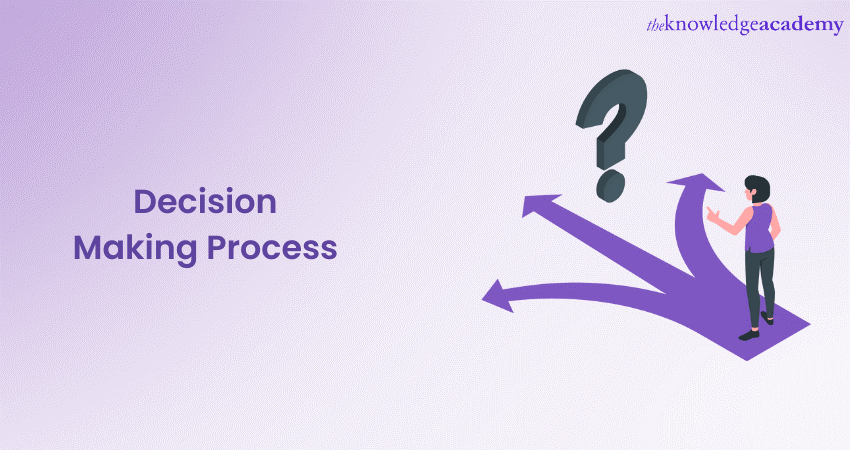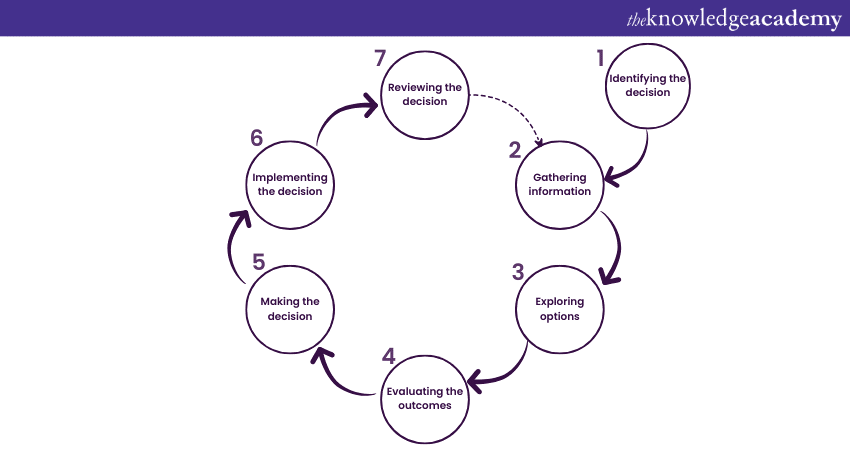We may not have the course you’re looking for. If you enquire or give us a call on +1800812339 and speak to our training experts, we may still be able to help with your training requirements.
Training Outcomes Within Your Budget!
We ensure quality, budget-alignment, and timely delivery by our expert instructors.

The Decision Making Process involves steps that guide individuals in evaluating options and considering relevant information. It can help you make informed and effective decisions in your personal and professional lives. Whether you're making choices in your career, relationships, or daily tasks, having a structured process can help you make informed and effective decisions. But do you know how does this process work? Read this blog to learn everything about the Decision Making Process, providing you with a step-by-step approach to tackle any situation.
Table of contents
1) What is Decision Making Process?
2) Seven steps in Decision Making Process
3) Tools for better Decision-making Process
4) Why is implementing a Decision Making Process important?
5) Conclusion
What is Decision Making Process?
The Decision Making Process refers to the systematic approach to making choices and reaching conclusions. It involves a series of steps that guide individuals or groups in evaluating options, considering relevant information, and ultimately selecting the best course of action.
The process aims to minimise uncertainty, biases, and impulsive judgments by providing a structured framework for logical thinking and analysis. At its core, the Decision Making Process involves the following:
a) Identifying Decision that needs to be made
b) Gathering information related to the Decision
c) Evaluating available options
d) Evaluating the outcomes of the options
e) Making a choice based on evaluation
f) Implementing the decision
g) Reviewing the decision and its impact
Each step is essential in ensuring a thoughtful and informed Decision. By following this process, individuals can enhance their ability to analyse situations and consider various perspectives. They can also choose the most suitable course of action.
Seven steps in Decision Making Process
The process of Decision Making typically consists of seven essential steps that guide individuals or groups in reaching informed and effective decisions. These steps provide a framework for systematic thinking and analysis. Let's explore each of these steps:

1) Identifying the decision
This step involves clearly identifying the specific Decision that needs to be made. Understanding the problem or opportunity at hand and defining the desired outcome is essential. By clearly understanding the Decision’s purpose and scope, individuals can focus their efforts on finding the most appropriate solution. This step sets the foundation for the rest of the Decision Making Process.
2) Gathering information
Once the Decision is identified, gathering relevant information is next. This includes conducting research, collecting data, seeking expert opinions, or consulting reliable sources. The goal is to acquire as much information as possible to make an informed decision. By gathering relevant and reliable information, individuals can gain insights, understand the various aspects related to the decision, and consider different perspectives.
Elevate your Decision-Making abilities and gain a competitive edge with our Practical Thinking Masterclass.
3) Exploring options
After gathering relevant information, one should explore the possible solutions to the problem. It is important to consider different methods to achieve the objective and evaluate their advantages and disadvantages. For instance, if a company aims to boost its social media engagement, it could weigh various options, such as investing in paid social advertisements, revising its organic social media strategy, or implementing a combination of both approaches.
4) Evaluating the outcomes
When making a Decision, it is important to evaluate the outcomes of each option. It means looking at the past successes and failures of similar situations and comparing them with the current scenario. It also means considering the risks and benefits of each option and how they align with the goals and values of the Decision Maker.
Evaluating the outcomes can help to eliminate unsuitable options and choose the best one based on evidence and logic. However, evaluating the outcomes can also be challenging, as it requires gathering relevant information, analysing it critically, and weighing it against other factors. Therefore, it is advisable to use a systematic and objective approach, such as a decision matrix or a pros and cons list, to help with this process. By evaluating the outcomes of different options, one can make better decisions that lead to desirable results.
5) Making the Decision
Once the options have been evaluated, the Decision Making Process moves to the actual decision. This step entails carefully considering all the available information, analysing the potential risks and benefits of each option, and selecting the best course of action. It’s important to trust one’s judgment, take into account the analysis conducted in the previous steps, and make a decision that aligns with the desired outcome. Confidence, clarity, and decisiveness are key in this step.
6) Implementing the Decision
The final step of the Decision Making Process is to implement the chosen Decision. It means putting the Decision into action and monitoring the outcomes. Implementing the decision requires planning, communication, and execution skills. The Decision Maker needs to perform the following:
a) Develop a plan that outlines the steps, resources, and timeline for implementing the decision. The plan should be clear, realistic, and flexible to accommodate any changes or challenges.
b) Assign roles and responsibilities to their team members and communicate the expectations. The team members should understand their tasks, deadlines, and deliverables. The Decision maker should also provide feedback and support to the team members throughout the process.
c) Execute the plan and monitor the progress and performance of the decision. The Decision maker should track the results of the Decision against the predefined success criteria. They should also identify any problems or risks that may arise and take corrective actions if needed.
7) Reviewing the decision
After implementing the Decision, the Decision Maker must review its impact and effectiveness. It means assessing whether the desired results are achieved and learning from the process. Reviewing the decision requires evaluation, analysis, and reflection skills. The Decision Maker needs to:
a) Measure the outcomes of the Decision against the success criteria. The outcomes should be quantifiable and verifiable using data and evidence.
b) Collect feedback from their team members, stakeholders, and customers on how the Decision affected them. The feedback should be honest, constructive, and comprehensive. It should cover both the positive and negative aspects of the decision.
c) Analyse the strengths and weaknesses of the Decision and identify the lessons learned for future improvement. The Decision Maker should examine what worked well and could have worked better in the Decision Making Process. They should also acknowledge their mistakes and successes and share their insights with others.
d) Celebrate the achievements and acknowledge the challenges of the Decision Making Process. The Decision maker should recognise and appreciate their team members’ efforts and contributions. They should also celebrate their growth and development as a result of making the Decision.
By following these steps in the Decision Making Process, individuals can approach Decisions with a systematic and thoughtful mindset. Each step emphasises the importance of gathering information, critically evaluating options, and making informed choices that align with desired outcomes. Through practice and experience, individuals can enhance their decision-making skills and make more effective decisions in various aspects of life.
Tools for better Decision-making Process
If you want to improve the Decision Making Process, you can use these following tools which are available at your disposal:
a) You can use SWOT analysis which stands for Strength, Weakness, Opportunities and Threats. This a good tool for assessing both internal and external factors that can affect decisions.
b) Using Decision matrix will help you to evaluate options against weighted criteria, so that you can objectively compare the alternatives.
c) You can use cost-benefit analysis to compare the costs and benefits of different Decisions and find out which is the more financially viable option.
d) If you are using the Pareto analysis (80/20) then it will help you to focus your efforts on the few actions which will help you produce the most significant outcome.
e) The most common tool that can also make your Decision Making Process better is a simple pros and cons list, which will help you weigh the advantages and disadvantages.
Why is implementing a Decision Making Process important?
Implementing a Decision Making Process is crucial as it provides a structured framework for rational and informed choices. It promotes clarity, ensuring a clear understanding of the problem and desired outcome.
Following a defined process, individuals can gather relevant information, analyse options, and evaluate risks and benefits. Consistency is achieved, leading to fair and transparent Decision Making. Further, accountability is enhanced as responsibilities are clearly defined.
Additionally, the process enables evaluation and learning, allowing for continuous improvement. Overall, implementing a Decision Making Process improves decision quality, fosters clarity, consistency, and accountability, and facilitates growth and development.
Learn how to make important Decisions effectively with our Decision Making Skills Training.
Conclusion
The Decision Making Process is a fundamental skill that can significantly impact our lives. Following a structured approach can minimise the risks associated with impulsive choices and increase the likelihood of achieving desired outcomes.
Take the next step in developing your leadership skills. Register for our Leadership Training now!
Frequently Asked Questions

You can use these strategies to minimise the influence of cognitive bias on the Decision Making Process:
a) Use structured Decision Making tools
b) Practice mindfulness
c) Be aware to avoid any biases
d) Employ critical thinking
e) Base your decisions on evidence.

If you want to adapt your Decision Making Process to accommodate uncertainty or dynamic environments, then you should embrace flexibility, analyse new information, employ new scenario planning and cultivate resilience to withstand setbacks.

The Knowledge Academy takes global learning to new heights, offering over 30,000 online courses across 490+ locations in 220 countries. This expansive reach ensures accessibility and convenience for learners worldwide.
Alongside our diverse Online Course Catalogue, encompassing 17 major categories, we go the extra mile by providing a plethora of free educational Online Resources like News updates, Blogs, videos, webinars, and interview questions. Tailoring learning experiences further, professionals can maximise value with customisable Course Bundles of TKA.

The Knowledge Academy’s Knowledge Pass, a prepaid voucher, adds another layer of flexibility, allowing course bookings over a 12-month period. Join us on a journey where education knows no bounds.

The Knowledge Academy offers various Leadership courses, including Design Thinking Course, Business Development Training, and Managing Innovation Course. These courses cater to different skill levels, providing comprehensive insights into Decision Making methodologies.
Our Business Skills blogs covers a range of topics related to Decision Making Process, offering valuable resources, best practices, and industry insights. Whether you are a beginner or looking to advance your Decision Making skills, The Knowledge Academy's diverse courses and informative blogs have you covered.
Upcoming Business Skills Resources Batches & Dates
Date
 Successful People Management and Team Leadership
Successful People Management and Team Leadership
Fri 19th Jul 2024
Fri 20th Sep 2024
Fri 22nd Nov 2024









 Top Rated Course
Top Rated Course



 If you wish to make any changes to your course, please
If you wish to make any changes to your course, please


